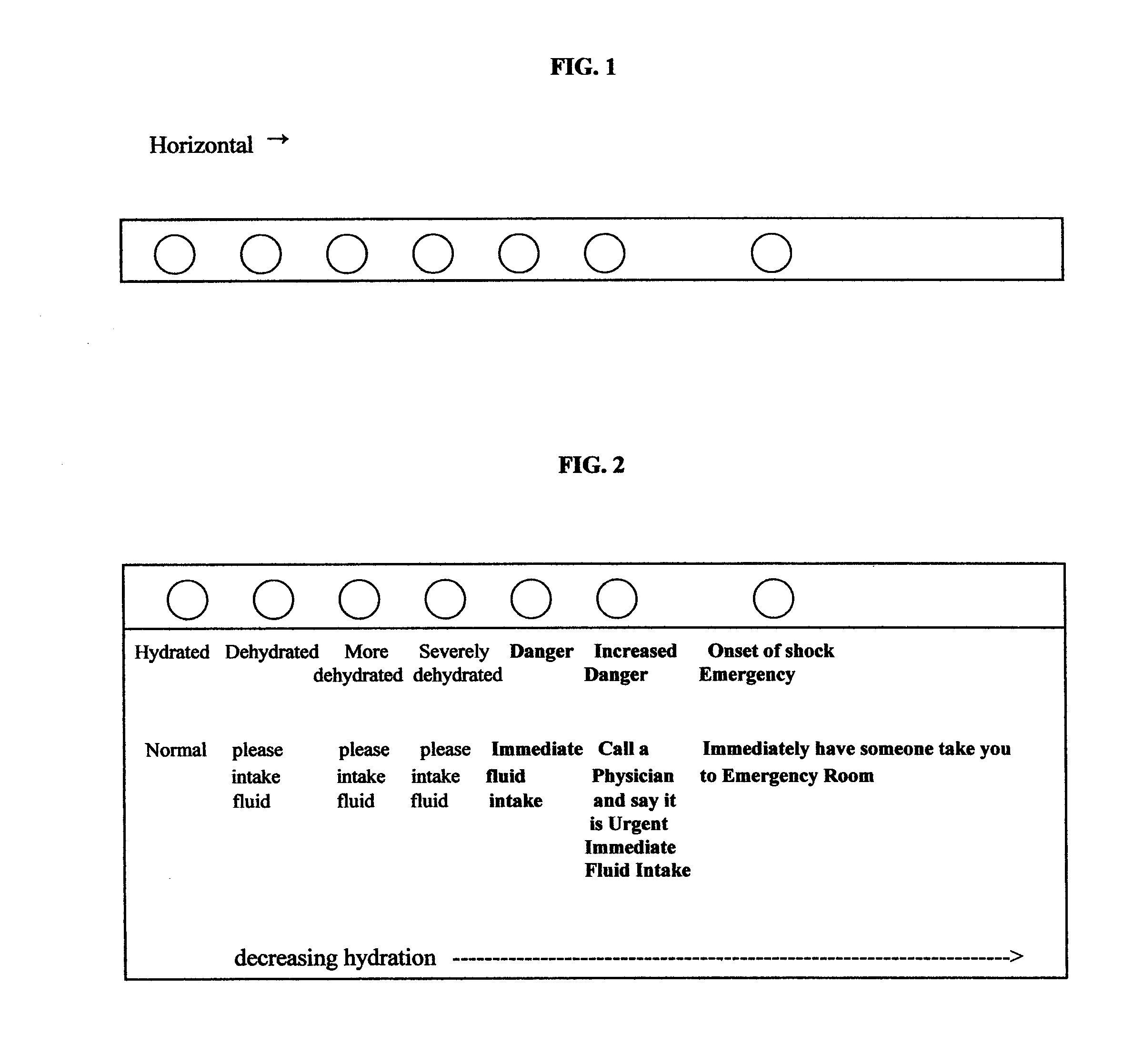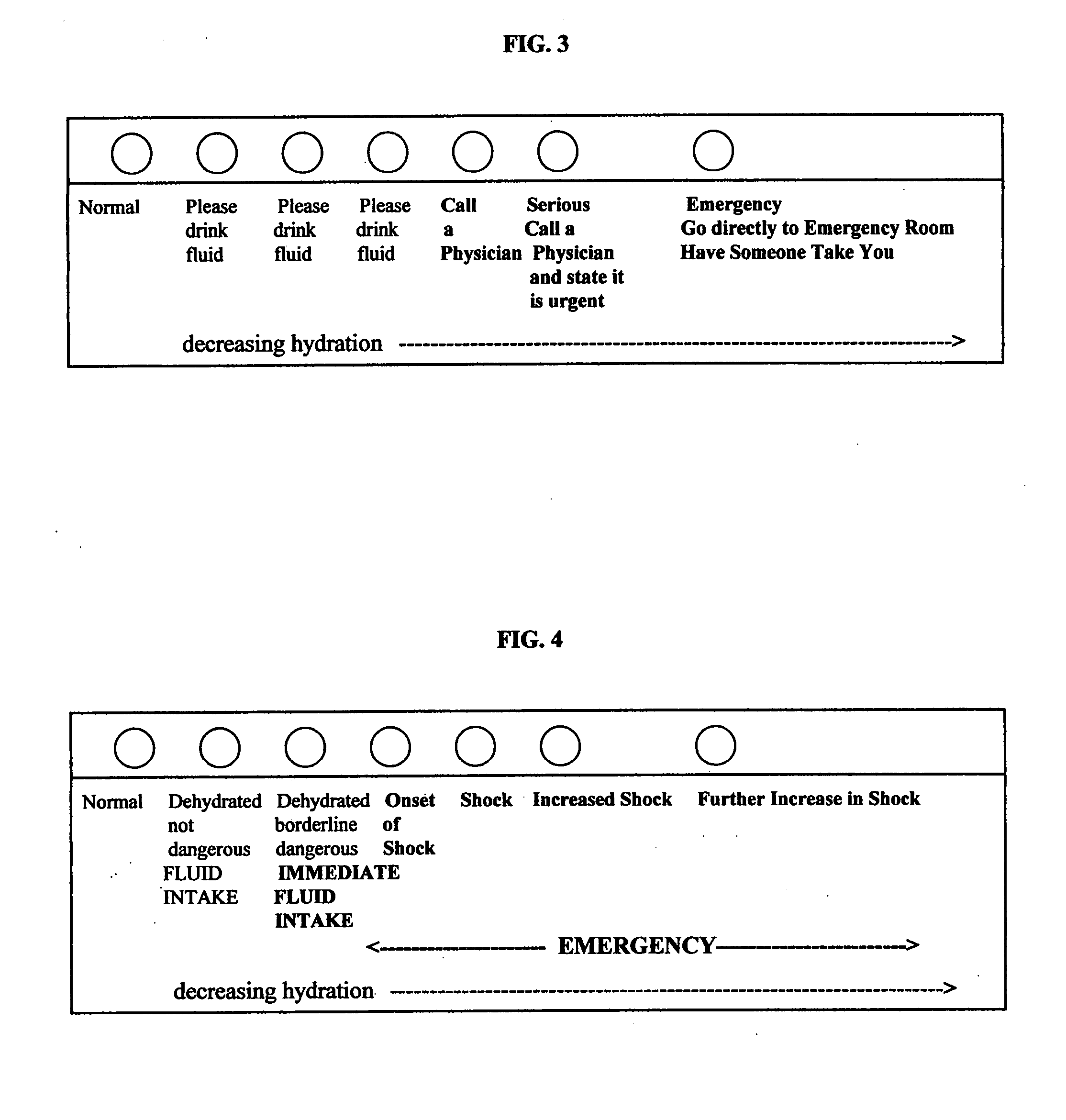Methods for assessing dehydration and shock, assays and kits for the methods
a technology of shock and dehydration, applied in the field of medical and consumer arenas, can solve the problems of insufficient blood volume, nervous system, and shock, and achieve the effect of preventing dehydration or shock
- Summary
- Abstract
- Description
- Claims
- Application Information
AI Technical Summary
Benefits of technology
Problems solved by technology
Method used
Image
Examples
example 1
Chemical Assay For Salivary Amylase
[0109] There are commercial assays for blood samples. For the clinical analysis of hyperamylasemia, it is important to assay for only the pancreatic amylase in the blood sample, and to exclude the salivary amylase that is also present. Various methods have been proposed for excluding the salivary amylase, these methods include: (1) separation by use of difference in charge (electrophoresis is used in clinical examination), (2) a gel filtration method, (3) an affinity chromatographic method, (4) an immunological method, (5) applying salivary amylase inhibitors (this method is used in clinical examinations).
[0110] In yet another example, amylase activity in blood and urine shows a remarkable increase in the case of pancreatic injury, pancreatitis, cancer of the pancreas, and parotitis when compared with normal values. In the commercial assays, serum samples are used and the assays must isolate the pancreatic amylase from the salivary amylase also p...
example 2
Assay for Determining Hydration Level of a Person
[0117] 25 μL saliva sample (test sample) collected from a human is added to 1000 μL of a commercially available reagent for the determination of amylase with 4-nitrophenylmaltohaptaoside (Boehringer Mannheim, Cat. Order No. 568589) according to the procedure in the manufacturer's instructions. The amylase activity of the test sample is determined at 37° C. according to the manufacturer's instructions. The controls contain varying amylase activities (corresponding to different hydration levels) are also determined according to the manufacturer's instructions. That is, the controls may be derived from the test protocols of Example 4, below, but using 4-nitrophenylmaltohaptaoside (Boehringer Mannheim, Cat. Order No. 568589) in the amylase assay according to the procedure in the manufacturer's instructions and the amylase activity is determined at 37° C. according to the manufacturer's instructions. The test sample's salivary amylase act...
example 3
Assay for Determining Hydration Level of a Person
[0118] 50 μL saliva (test sample) collected from a human is used in a commercially available amylase test with blue-colored, high polymer starch substrate (Pharmacia Diagnostics AB, Uppsala, Sweden, Catalogue Order No. 93-986-2-1393-02) according to the manufacturer's instructions, and determined at 37° C. The controls contain varying amylase activities (corresponding to different hydration levels) are also determined according to the manufacturer's instructions. That is, the controls may be derived from the test protocols of Example 4, below, but using the commercially available amylase test with blue-colored, high polymer starch substrate (Pharmacia Diagnostics AB, Uppsala, Sweden, Catalogue Order No. 93-986-2-1393-02) according to the manufacturer's instructions, and determined at 37° C. The test sample's salivary amylase activity is compared to those of the controls. The control most closely matching the test sample is noted, and...
PUM
 Login to View More
Login to View More Abstract
Description
Claims
Application Information
 Login to View More
Login to View More - R&D
- Intellectual Property
- Life Sciences
- Materials
- Tech Scout
- Unparalleled Data Quality
- Higher Quality Content
- 60% Fewer Hallucinations
Browse by: Latest US Patents, China's latest patents, Technical Efficacy Thesaurus, Application Domain, Technology Topic, Popular Technical Reports.
© 2025 PatSnap. All rights reserved.Legal|Privacy policy|Modern Slavery Act Transparency Statement|Sitemap|About US| Contact US: help@patsnap.com



